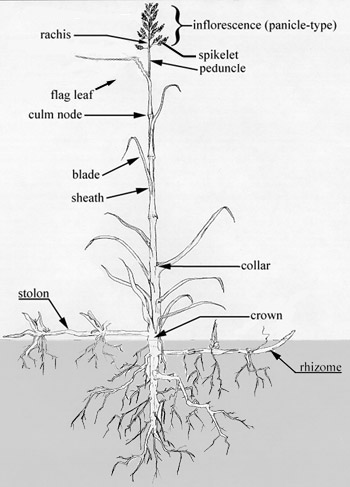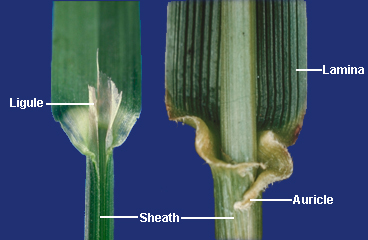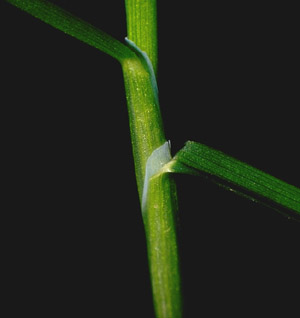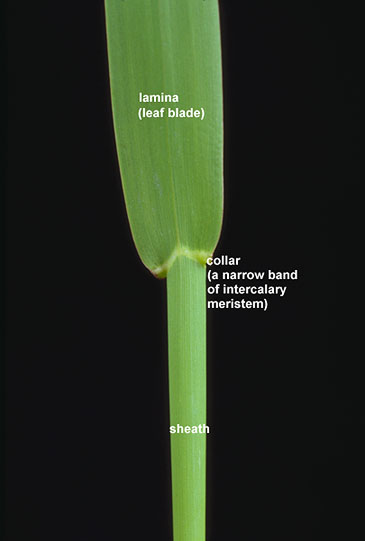Nomenclature of Vegetative and Floral Structures
Knowing the names of specific plant parts will provide a foundation for in-depth discussions of mechanisms which account for growth and recovery following defoliation. The diagram and definitions are divided into three categories: vegetative, floral (reproductive), and collar. During early growth, while a grass plant is vegetative, identification is difficult. When floral structures are visible, identification is easier. The collar region is helpful for identification and it contains a band of intercalary meristem which, when properly safe-guarded, will account for regrowth following mowing or grazing.
Vegetative Structures
Notice the following labeled items on the drawing:
-
peduncle: upper most culm segment supporting the seed head.
-
flag leaf: uppermost leaf of the culm, enclosing the seed head during the boot stage.
-
culm node: solid region on the culm which gives rise to a leaf sheath. On certain grass species, lower culm nodes may bear adventitious buds capable of producing new tillers.
-
culm: central axis of the mature grass shoot, comprised of nodes and internodes; each node bearing a leaf.
-
leaf blade: part of the leaf above the sheath, also known as the lamina.
-
leaf sheath: lower section of a grass, enclosing its associated culm internode.
-
auricles: short, often claw-like appendages at the base of the leaf blade which tend to clasp the sheath at the culm internode. The various shapes can be useful for identifying certain grasses.
-
ligule: a variously modified extension of the sheath lying at the base of the blade; often a vertical membrane, and in certain cases, mere bristles.
-
crown: basal zone of the shoot, the origin of which was tissue at the base of the coleoptile during the seedling stage. The crown is essential for the perennial growth of the plant as this zone is comprised of over-wintering tissues (basal internodes, rhizomes, stolons, corms) which produce new shoots the following spring. Annual grasses do not develop a crown.
-
stolon: a prostrate or creeping, above-ground stem, rooting at the nodes; a means of vegetative reproduction.
-
rhizome: a prostrate subterranean stem, capable of rooting at the nodes and becoming erect at the apex; a means of vegetative reproduction.
-
tiller: a daughter plant, a shoot capable of producing a new plant.
-
meristem: the cells capable of growth.
-
collar region: The collar region of the leaf is the most useful area for identifying vegetative-stage grasses. Later on, after seed head emergence, floral structures may provide a more obvious means of identification. The collar region consists of the leaf blade, the leaf sheath wrapping around the stem, auricles (if present), a ligule, and connective tissue called the collar. Each species is unique with respect to the presence, size, and shape of the auricles and ligules in this leaf zone. The collar (connective tissue) is a narrow band of intercalary meristem (tissue capable of growth) which accounts for blade growth. With immature blades, this meristem provides for further blade growth following defoliation.
The first photographs show a collar with the blade (lamina), auricles, ligule, and leaf sheath.
-
blade (lamina): part of the leaf above the collar
-
collar: a thin band of meristematic tissue at the junction of the leaf blade (lamina) and the sheath
-
auricles: claw appendages at the base of the blade of some grasses (some grasses do not have auricles)
-
ligule: outgrowth at the inner junction of the leaf sheath and blade, often membraneous, sometimes a fringe of hairs
-
sheath: lower part of the leaf that encloses the internode
The middle photograph shows the collar, where intercalary meristematic tissue is seen (lighter in color) just underneath the top leaf blade. The lower leaf blade is bent back showing the ligule but a portion of whitish collar can be seen at the edge of the fold.
The bottom photograph shows the collar, the narrow band of meristematic tissue of a timothy plant.



The collar region is also important in grass management. When properly safe-guarded, this band of intercalary meristem will account for continued blade growth following mowing or grazing of immature leaf blades.
Floral Structures
-
inflorescence: flower head terminating the stem, consisting of a collection of flowers arranged on a common axis. There are three main grass inflorescence types: 1. panicle, 2. spike, 3. raceme.
-
rachis: central axis of seed head.
-
spikelet: a flowering unit comprised of one or more florets enclosed by two glumes (bracts). When the spikelets are attached directly to the rachis the inflorescence is called a spike (wheat, rye, barley, ryegrass). When the spikelets are attached to the rachis with short pedicels, the inflorescence is termed as raceme. When the spikelets are attached by means of a branch the inflorescence is said to be a panicle.
-
pedicel: in grasses, a short stem segment supporting a spikelet. Such spikelets are said to be pedicellate.
-
glume(s): bracts which enclose the floret(s). A spikelet can be described as a ""pair"" of glumes with the enclosed floret(s). The outer (lower) glume is always the largest of the pair. In some species (Paniceae family) the uppermost glume is greatly reduced and is largely replaced by the lemma of a sterile floret contained within.
-
floret: small flower; the reproductive unit of a grass spikelet consisting of a lemma and palea and the small flower they contain (see spikelet).
-
rachilla: the segmented central axis of a spikelet is prominent in spikelets which bear two or more fertile florets. Each rachilla segment bears a floret, thus in threshed form, a single seed usually retains a rachilla segment or joint. The presence or absence of a rachilla segment provides a means of recognizing many seeds. Further, the shape and size of the segment is widely contrasted among species.
-
lemma: the larger, outer, bract which, along with the palea, serves to contain the floret(s) held within. The lemma and palea provide a protective covering for the developing floret as well as for the seed after ripening.
-
awn: a fibrous bristle (often called a beard) which is an extension of the midrib of the lemma. It may arise from the tip of the lemma or from the abaxial (outer) surface below the tip.
-
beard: common term for awn.
-
palea: the shorter, upper, bract which, along with the lemma, serves to contain the floret(s) held within (see lemma).
-
stamens: the male organ of a flower supporting anthers which produce pollen.
-
anther: the pollen bearing portion of a stamen, composed of one or two pollen sacs.
-
pollen: the structures that result from the maturation of a microspore.
-
pistil: the female organ of the flower comprised of the stigma, style, and ovary. The stigma receives pollen grain, which upon germination, produces a pollen tube which passes through the stigma into the ovary.



